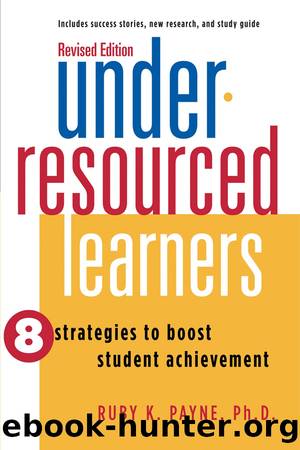Under-Resourced Learners: 8 Strategies to Boost Student Achievement by Ruby K. Payne

Author:Ruby K. Payne [Payne, Ruby K.]
Language: eng
Format: epub
ISBN: 9781938248894
Google: AXMKugEACAAJ
Publisher: Aha Process
Published: 2017-11-15T23:21:29.156953+00:00
A Summary of Key Factors Regarding Each of the Biochemical Issues
PLEASE NOTE: An accurate diagnosis can be made only by a trained developmental pediatrician, a psychiatrist, or a certified individual in the area of mental health. The purpose of this summary is simply to alert educators to the identifiers that may signal the need for referral to a trained professional.
It also should be noted that almost every human being likely will display some of these characteristics from time to time. The issue to note in biochemical issues is the number, frequency, and pervasiveness of the disorder. What is the pattern? In other words, can this student deal with reality in a constructive manner? Can the student relate to other people in a fairly consistent way with mutual respect and satisfaction?
For example, everyone from time to time is distracted, is angry, is impulsive, cannot sleep, etc. Does it occur once a month, every week, or every day? Does it disrupt the ability to have friends, succeed in school or at work, and/or cause damaging behaviors to self or others? It is the pattern and the disruption that begin to indicate the biochemical issue.
What is normal? The definitions are numerous. Sigmund Freud's definition was âto be able to work and love.â Some define it as an absence of symptoms, nothing in excess, the mean. Others define it as the ability to have self-control, to be predictable, to use past experience, to be your own person (yet interact with others), and to be able to adapt to change.
In general, the internal reality of an individual is usually shared by others in the external reality. In other words, if you are the only person among many who is seeing snow, chances are that it is not snowing. No other person around you is experiencing that reality. What is normal is usually defined in relationship to a group of common behaviors, perceptions, and emotions, along with their lack of disruption in daily life.
Schizophrenia
The schizophrenic individual gives a common perception special or unusual significance, then elaborates or takes the perception into hallucination or delusion. Often voices are heard. The voices refer to the individual in the third person; the voices may make a monologue about the individual's behaviors/thinking/feelings. One college sophomore who was schizophrenic didn't sleep all weekend and kept a Coke bottle by her bed. She believed that the 90-year-old man who was in the apartment above hers was going to come in at night and rape her. There was no evidence that he even knew that she lived in that apartment. The Coke bottle was going to be her main weapon of defense.
Obsessive-Compulsive Disorder (OCD)
The OCD individual engages in rituals for all manner of daily tasks and activities, including eating, sleeping, dressing, personal hygiene, school, and work. The individual may be compelled to engage in repetitions of a behaviorâe.g., checking the locks repeatedly or washing hands constantly. The individual repeatedly touches, rubs, counts, and/or orders objects. In addition, sequences are very important. Hoarding and collecting can be indicators.
Download
This site does not store any files on its server. We only index and link to content provided by other sites. Please contact the content providers to delete copyright contents if any and email us, we'll remove relevant links or contents immediately.
Navigation and Map Reading by K Andrew(5111)
Spare by Prince Harry The Duke of Sussex(5078)
Tuesdays with Morrie by Mitch Albom(4696)
Cracking the GRE Premium Edition with 6 Practice Tests, 2015 (Graduate School Test Preparation) by Princeton Review(4227)
Machine Learning at Scale with H2O by Gregory Keys | David Whiting(4197)
Never by Ken Follett(3800)
Goodbye Paradise(3729)
What It Really Takes to Get Into Ivy League and Other Highly Selective Colleges by Hughes Chuck(3697)
Harry Potter and the Prisoner of Azkaban (Book 3) by J. K. Rowling(3304)
Fairy Tale by Stephen King(3223)
Pledged by Alexandra Robbins(3136)
Kick Ass in College: Highest Rated "How to Study in College" Book | 77 Ninja Study Skills Tips and Career Strategies | Motivational for College Students: A Guerrilla Guide to College Success by Fox Gunnar(3077)
A Dictionary of Sociology by Unknown(3031)
Sapiens and Homo Deus by Yuval Noah Harari(2988)
Reminders of Him: A Novel by Colleen Hoover(2952)
The Social Psychology of Inequality by Unknown(2941)
Graduate Admissions Essays, Fourth Edition: Write Your Way into the Graduate School of Your Choice (Graduate Admissions Essays: Write Your Way Into the) by Asher Donald(2878)
Will by Will Smith(2795)
Zero to Make by David Lang(2727)
